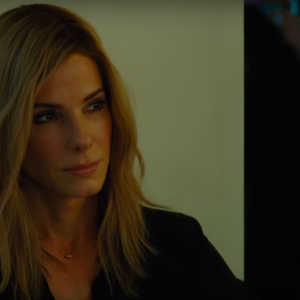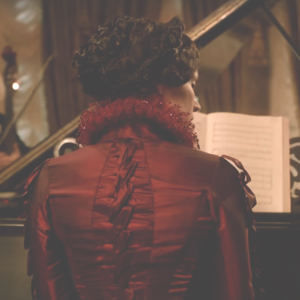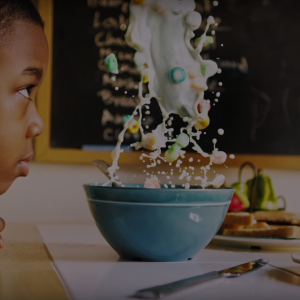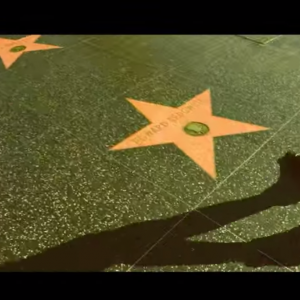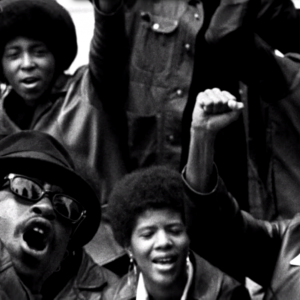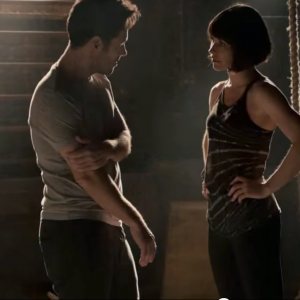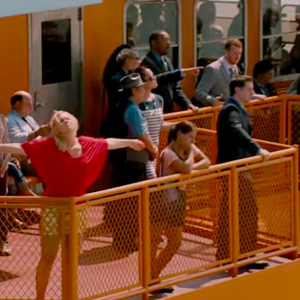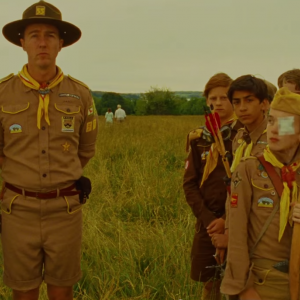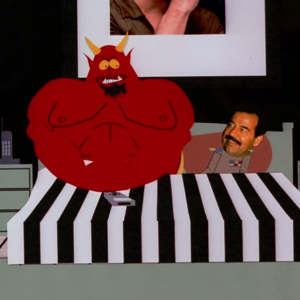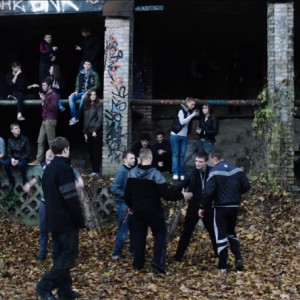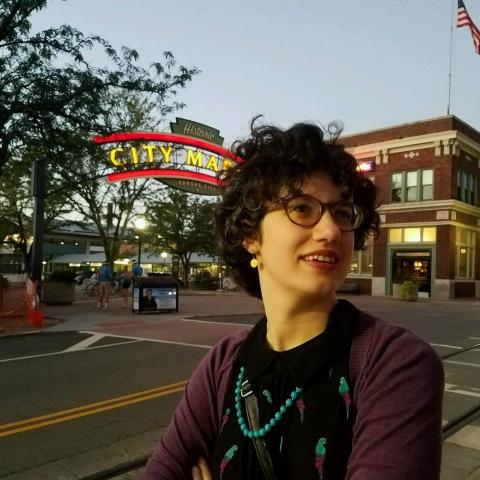
Abby Olcese (@abbyolcese) has been many things — a campus ministry leader at the University of Kansas, an English teacher in Prague, and an advertising assistant at Sojourners. These days, she’s a freelance writer based in Kansas.
Raised on a diet of Narnia, Bob Dylan records and Terry Gilliam movies, Abby is drawn to the weird, the nerdy, and the profoundly artsy corners of popular culture. She loves sharing this knowledge with others by writing about interesting new releases as well as lesser-known gems.
Abby is also passionate about the intersection of faith, social responsibility, and culture. She believes in the power of art to spark important conversations, inspire social change, and help people to better understand life in the kingdom of God.
When she’s not watching movies or writing things down, you can usually find Abby reading comic books or perusing the selection at her local record store.
Posts By This Author
'Brooklyn' and the Stories That Made America
There are many reasons to recommend Brooklyn — its relatable story for one, its glowing visuals and performances for another. But Brooklyn’s commendable qualities go far beyond this, including the amount of respect writer Nick Hornby and director John Crowley give the movie’s female protagonist. Brooklyn is a movie about hard choices, and for the most part, Eilis makes those choices on her own. At different points in the film, she’s caught between romantic relationships, and familial and personal obligations. But in none of these situations does it feel like her hand is forced. The movie lets us know early that Eilis can take care of herself, and she’s never forced to compromise on that point, though she easily could have been.
Although politics aren’t really on Brooklyn’s agenda, the film also carries an unintentional point on that score worth considering. At a time when the United States is anxious about welcoming refugees and immigrants, this film reminds us that our country is made up largely of immigrants — some who look like Eilis, but also many who don’t.
'The 33' Wears Its Heart on Its Sleeve
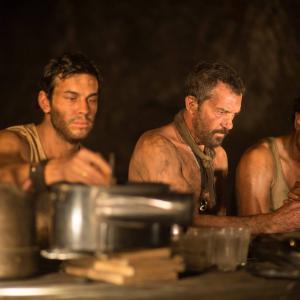
Still from the movie 'The 33' / via The 33 Movie on Facebook
The 33, a dramatization of the 2010 San Jose mine collapse in Chile, has all the markings of a Hollywood tentpole film. Heartfelt, incredible true story: check. Touching human drama: check. Stirring score: check (it’s one of the last created by composer James Horner before his death in June, giving it extra poignancy). There are more lines about “not giving up” than there are tears in an Oscar acceptance speech. The 33 fits the end-of-year crowd-pleaser profile in every way.
The 33 tells the famous story of the collapse of the gold mine in Chile’s Atacama desert from three different perspectives.
'Suffragette' Comes Out Swinging
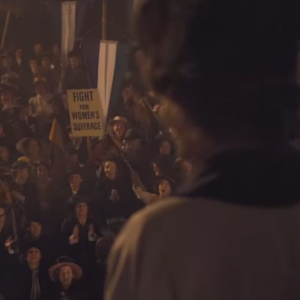
Screenshot via 'Suffragette' Trailer/YouTube
Though some critics have claimed that the film doesn’t do enough to show the effects of the suffrage movement, it seems appropriate that Suffragette ends while the fight is still going on. In the era of Black Lives Matter, battles for reproductive rights and immigration reform — causes with hoped-for but still undetermined outcomes — it’s reassuring the see a film that portrays historical characters in a similar situation. The women of Suffragette are confident in their eventual victory not because they know what will happen. They’re confident because they have to be — because for them, allowing defeat was not an option.
'Our Brand Is Crisis' Is a Victim of Its Own Satire
The point of the film, ostensibly, is to show how damaging America’s highly-competitive political nature is by applying it to a situation where the country’s people stand to lose a lot very quickly if the wrong person wins. However, writer Peter Straughan makes the fatal error of making the film almost entirely about Bullock and Thornton’s goofy one-upsmanship. This not only comes off as disrespectful, it avoids giving the audience valuable contextual information about the actual race — we have no idea what’s at stake, or what the candidates really believe.
Once the consequences of the election come to pass, we’re given a last-minute redemption arc that has Jane joining forces with a young Bolivian campaign volunteer (Reynaldo Pacheco) and his friends in a protest, and then later starting a career campaigning for Latin American rights. It’s the one part of the film that takes its politics seriously. But here again, the story isn’t about the people who are actually suffering — the people who have to live with the man they were manipulated into electing. It’s about Jane, the American, who at the end of the day still gets to leave it all behind.
The Haunting Spirituality of 'Crimson Peak'
Guillermo Del Toro’s atmospheric horror movies usually exhibit an emotionally deep fascination with the supernatural. The director’s ghosts, while frightening in appearance, often don’t actually wish ill on the innocent people they haunt. Instead, they tend to be spectral echoes with unfinished business, who seek revenge and try to warn those still in harm’s way.
While actual discussions of God and religion don’t come into play much in Del Toro’s work, it’s still possible to find this approach deeply spiritual. In each of the worlds he creates, the audience is asked to take the supernatural world as a given — one that exists right alongside our own, with thin barriers that frequently give us brief views (both sublime and terrifying) into the other side. Those brief views throw our own world into sharp relief, showing us the beautiful and ugly realities of real life.
This same approach colors much of gothic literature — a genre that resonates strongly with Del Toro, particularly in his latest entry, the gorgeous, spine-tingling Crimson Peak. It’s a film riddled with characters whose lives are marked by ghosts, both real and emotional. Crimson Peak is not a perfect film, but it does many things well, including the patina of human tragedy it paints on top of its creaking floors.
'99 Homes' Exposes the Pain of Foreclosure for (White) Americans
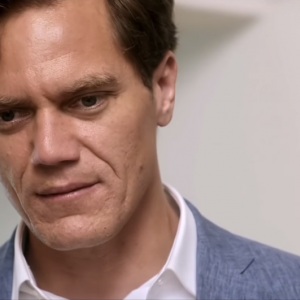
Photo via YouTube / Broad Green Pictures
How do we measure our success? Matthew 6:19-21 warns us against putting our store in earthly things, which are temporary, but American capitalist culture informs us that the stuff we have — the size, the quality, and how much of it we can afford — is what determines our own worth. As Christians, we try to focus on serving God and loving our neighbors, but often it’s a moment of crisis that reveals where our values truly lie.
The film 99 Homes doesn’t include overtly religious elements, but it features that same battle at the heart of its story, a deal-with-the-devil tale set against the 2008 housing market crash. Writer-director Ramin Bahrani presents the film in an unstylized, utterly human way that explores this question from a dire perspective: how people react when everything they’ve worked hard to earn is yanked away, and they must suddenly re-evaluate their own measures of success.
'There Is No Why': The Unbearable Lightness of Robert Zemeckis

Screenshot via Sony Pictures Entertainment / Youtube
At one point in the new film The Walk, high-wire walker Philippe Petit (Joseph Gordon-Levitt) is asked, after successfully walking a tightrope strung between the two towers of the World Trade Center, why he chose to perform such a dangerous, death-defying act. His answer: “There is no ‘why.’ I just look for a place to hang my wire, and when I find it, I put it there.”
There are a couple of ways you could take this statement. One is a thrilling feeling of limitless possibility. The other is a little more disconcerting: that there was no deeper meaning; Petit simply did it because, well, why not?
This New Superhero Comic Stars the Superhero's Single Working Mom
However, even among multi-tasking, family-oriented comic book stars, Nicole, the star of the new independently published series Raising Dion, is unique. A widowed, black single mother, Nicole has no superpowers of her own. Her son, Dion, is the one with emerging superhuman abilities.
The comic, created and written by Dennis Liu, aims to show readers what it’s like to raise someone who may become the next great superhero...or the most terrifying supervillain the world has ever seen.
The first issue of Liu’s new comic (available as a free download from the author’s website) introduces readers to Nicole and Dion, and tells the story of how Nicole met her husband Mark, Dion’s father. One night, on a camping trip, Mark witnesses a strange phenomenon in the sky, and is struck by a powerful flash of light. Whatever side effects Mark picks up from his experience, he passes on to his son when Dion is conceived.
When the Enemy Lives Next Door
On a macro level, however, The Look of Silence is equally important in its examinations of evil, guilt, consequence, and forgiveness. It’s a horrifying document of the cruelty humans are capable of, and the ways we try to justify our sins, especially those that are very clearly unjustified. It’s also an incredible example of the courage and grace to seek reconciliation — which, through Adi’s example, Oppenheimer shows we’re equally capable of. The Look of Silence is required viewing, equal parts frightening and beautiful, much like the landscape it portrays.
Why the Transgender Representation in ‘Tangerine’ is Important
When a movie examines a group of people whose stories are only starting to gain mainstream attention — and does it with honesty and compassion — it’s important to pay attention. Director Sean Baker’s wickedly funny and stylish film Tangerine dives deep into the transgender community in Los Angeles in a way that explores the strengths, vulnerabilities, and deep needs of its characters. In other words, it portrays them as real people, not as caricatures — or Oscar-friendly approximations played by a cisgendered actor in drag.
How Much Do You Know About the Black Panthers?
We learned about sit-ins, bus boycotts, Martin Luther King, and Malcolm X. But when it came to the Black Panthers, I was taught virtually nothing. I can vaguely recall a high school teacher mentioning Huey Newton, and showing photos of John Carlos and Tommie Smith giving the Black Power salute at the 1968 Olympics. That’s it.
We didn’t hear about the origins of the Black Panthers, or their active improvement of local communities. We didn’t hear about the personalities that created both important exposure and also infighting. We didn’t hear the story of the federal government’s fear of the Panthers or its insidious undercover missions, whose implementation prompted senseless killing and violent responses.
What we didn’t hear, in short, is everything The Black Panthers: Vanguard of the Revolution covers.
'A-Force' for Gender Equity

Image via Murray/Shutterstock
Even before it hit comic store shelves in May, Marvel’s all-female series A-Force started picking up attention — most of it well-deserved. Co-written by Marguerite Bennett and G. Willow Wilson, whose other credits include a series starring a Muslim teenage girl (see "Real Life, With Superpowers," Sojourners, August 2014),A-Force is Marvel’s new, lady-led Avengers team, who patrol and protect the island community of Arcadia.
Or as New Yorker staff writer Jill Lepore said in a less-than-complimentary essay, "A-Force is a race of lady Avengers, led by She-Hulk, who come from a ‘feminist paradise,’ but I don’t know what that could possibly mean, because they all look like porn stars."
Lepore’s argument is that for all its positing as the latest in a series of progressive moves by Marvel, A-Force’sgender representation leaves much to be desired. The series features heroines who are, in several cases, female versions of existing male superheroes, rather than their own independent characters.
"Marvel is trying very hard to deal with the fact that its superheroes are mainly men and just turning them into women seemed as good a plan as any," argues Lepore, who recently wrote a book on Wonder Woman’s feminist origins.
Marvel's Female Representation: Taking 'Ant-Man'-Sized Steps
In many ways, Ant-Man — Marvel’s latest addition to its cinematic superhero pantheon — feels like a response to criticisms leveled at the studio lately. Namely: the films’ lack of any female superheroes; and their penchant for rampant destruction with little regard for the consequences. Ant-Man handles the latter with a gonzo sense of creativity and clever humor. Marvel’s response to female representation issues, however, doesn’t quite stick the landing.
Hope is an excellent fighter and extremely smart. With her knowledge of her father Hank’s work and her role within Pym Industries, she’s the natural choice to lead the mission for which Scott Lang is recruited. But she gets stuck on the sidelines. While the film addresses this through Hank’s concern for her well-being, as well as his experience losing Hope’s mother Janet in action — a choice that certainly makes sense for Hank’s character — Ant-Man chooses to let the matter lie there, instead of further addressing it. A post-credits scene shows Hope getting her own costume, though as of yet, she won’t be getting her own film.
'Trainwreck:' Amy Schumer Goes Longform
Amy Schumer and Judd Apatow’s Trainwreck promises rude, clever fun. Does it deliver? Abby Olcese and Catherine Woodiwiss discuss. (Light spoilers in parentheses.)
Catherine Woodiwiss: Okay, so I was a little concerned that Trainwreck was just going to be an exact inversion of "the guy’s a mess, the girl’s uptight" Judd Apatow comedy set-up. And it’s not just that! But I am a little surprised how conventional it felt ultimately.
Abby Olcese: I enjoyed it. I enjoyed her getting to be a mess. Right up until the point where she breaks up with Jon Cena — which is an absurd sentence that I just said — up until that point, she’s really awful. But(Spoiler) when her dad died, and when Aaron visited for the first time and took care of him, those were very conventional story beats (End spoiler). I’m curious about that.
In her show, the Aaron Sorkin parody, the 12 Angry Men parody are really pointed, specific things and she’s using those tropes for a reason. So I wondered if that had a larger purpose in the long form. And I’m not entirely sure it did.
Woodiwiss: Amy’s style of comedy has always been a blend of pointed commentary and "do what the guys do but be a girl doing it." I thought it very subtle and clever that any on-screen nudity was male. And really, there was a significant range of interpretation of masculinity in the film — the impossibly muscular bro who was gay, the intern who was possibly transgender. Bill Hader, who is not the stereotypical leading man. And LeBron James, who is basically the Platonic form of male athlete.
But the women didn’t have the same diversity — they were all pretty stock characters.
And her dig at cheerleaders (derisively comparing them to strippers) was odd. Was that a subtle skewering of the "girl gets boyfriend and gets protective and starts denigrating other women" trope? Maybe, but it just sounded like a cheap shot.
Olcese: The last thing I wrote down was, was that really just all over the place?
Woodiwiss: Say more.
Real Life, With Superpowers
I REMEMBER THE FIRST TIME someone told me I couldn’t do something because I was a girl. I was in preschool, preparing for an epic game of Teenage Mutant Ninja Turtles with a group of boys. I was playing April O’Neil, the Turtles’ journalist ally. As we started our game of pretend, my teacher came over to ask what we were doing.
“Playing Teenage Mutant Ninja Turtles,” I responded.
“Oh, you shouldn’t be playing that.”
“But I’m April,” I explained. “I’m a girl.”
“No, girls don’t play games like that,” she told me, and directed me toward the finger paints.
Whatever my teacher’s intentions, the damage was done. From that day on, superheroes and all things related were a “boy thing.” That meant the X-Men, Batman, Superman, and, yes, Donatello and his human-reptile hybrid team were all off-limits. I eventually grew to love comics as a teenager and an adult, but I was aware that they rarely featured anyone other than white men (or, occasionally, heavily objectified women) as the heroes.
Thank goodness for Kamala Khan.
Kamala is the teenage protagonist of Marvel Comics’ rebooted Ms. Marvel series. She’s a clever, funny 16-year-old living in Jersey City, N.J., who, in addition to having superpowers, writes superhero fan fiction, plays video games, and struggles with parent-enforced curfews. She also happens to be the second-generation daughter of Pakistani immigrants and a practicing Muslim.
Meet Dylan Marron, the Creator of 'Every Single Word'
Actor and writer Dylan Marron is the creator of Every Single Word, a popular tumblr and video series dedicated to exposing the lack of racial diversity in mainstream Hollywood films.
For the series, Marron, a biracial native of Venezuela best known for his work on the cult-favorite podcast Welcome to Night Vale, chooses a well-known, recent film and edits it down to only the lines spoken by people of color. The results are damning. None of the videos in Marron’s series last over a minute. Some, like Noahand Into the Woods, which feature no actors of color at all, simply cut directly to black.
Marron spoke with Sojourners about the origins of the project, the long-term effects of poor diversity representation onscreen, and systemic struggles facing people of color in the entertainment industry.
The Devil Goes Pop
As Jenna Barnett wrote yesterday in "The Devil We Know," the way Christians have thought about the devil has changed over time — and continues to change. The same is true of pop culture where a long fascination with depictions of the afterlife has led to some diverse and enduring depictions of Hell, demons, and even the devil himself. More recently, popular versions of demons and the devil have been particularly creative, from exploring Satan’s retirement to demented sock puppets. Here are just a few — six, to be precise — of the devils’s most loved (and hated) portrayals in books, movies, T.V., and beyond.
1. The Devil (Faust / Doctor Faustus)
One of literature’s most popular depictions of the devil, this version of the prince of darkness has gone on to inspire countless recreations in film, T.V., theater, and music. Beginning life as a German legend, then the subject of plays by Christopher Marlowe and Johann Wolfgang von Goethe, Doctor Faustus (or Faust) is the story of a scholar who sells his soul to the devil for the ability to practice magic. The devil as a shrewd dealer of desires can also be found in the music of Robert Johnson, stage productions like Damn Yankees, and T.V. shows like Supernatural, among countless other examples.
Appears in: Literature, Theater (Faust, Doctor Faustus)
Transcending Language, 'The Tribe' Is a Brutal Work of Art
Sometimes art is ugly. It carries with it as much capacity for violence and dread as it does transcendent beauty. This is true for film as much as it is with any other medium — it’s why we can have movies like Paris, Texas and Children of Men, and respect them in equal measure.
Difficult subject matter, particularly of the violent or sexual variety as in The Tribe, doesn’t make a film less credible. It’s what the director does with that subject matter that tells us how to react.
Sometimes art is ugly. It carries with it as much capacity for violence and dread as it does transcendent beauty. This is true for film as much as it is with any other medium — it’s why we can have movies like Paris, Texas and Children of Men, and respect them in equal measure.
Difficult subject matter, particularly of the violent or sexual variety as in The Tribe, doesn’t make a film less credible. It’s what the director does with that subject matter that tells us how to react.
Recognizing Each Person's Intrinsic Value in 'Inside Out'
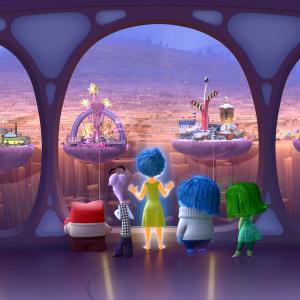
Image via Disney's 'Inside Out'
A mixture of thoughtful messaging and imaginative storytelling is what’s made many of Pixar’s films into modern classics. But the studio’s latest release, Inside Out, may include its most poignant theme yet: the complex emotional workings and unique roles of each and every human being.
Inside Out is a film that allows viewers to literally go inside the heads of its characters, and understand why they think the way they do. It’s a clever “what if” exercise, but also an opportunity to deeply explore the specific memories, assemblages of emotions, and detailed thoughts that make us special.
'Jurassic World' and the Problem with Hollywood Reboots
Among the big releases this summer, two films offer new installments of iconic franchises. One, Mad Max: Fury Road is a master class in how to do it right. Made as a labor of love, not a studio cash-grab, it uses a familiar setting and hero to explore new artistic territory, and still maintains an insanely entertaining level of action.
The other is Jurassic World.

